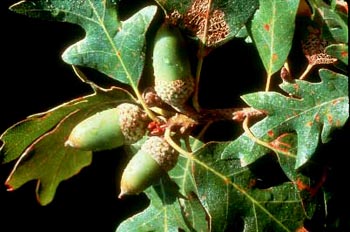Gambel Oak

Common Name(s):
Gambel Oak
Scrub Oak
Scientific Name:
Quercus gambelii Nutt.
Scientific Name Synonyms:
None known
Symbol:
QUGA
Description:
Life Span: Perennial
Origin: Native
Season: Deciduous
Growth Characteristics: A clone forming, monoecious shrub or small tree growing 6 to 30 feet tall. Gambel oak flowers March to April, the fruits mature in the autumn of the first year after flowering. It reproduces from seed, root sprouts, and tillers.
Flowers/Inflorescence: Inflorescence is a unisexual catkin. Male catkins are long and many flowered. Smaller female catkins are located at the branch apex.
Fruits/Seeds: Acorns, solitary or clustered. Cup (involucre) covering nearly half of its length. The acorn is usually yellowish brown when shed in the fall.
Leaves: Leaves are about 5 inches long with three or four rounded, deeply cleft lobes on each side of the central vein. The lobe tips are smooth, without spines or teeth. The leaves are bright green and shiny on top, and dull green, and hairless to slightly hairy beneath. They change in color to yellow or reddish brown in autumn when they fall.
Stems: Twigs are slender, brown to reddish-brown, hairy to smooth, becoming grayish-brown. They are usually crooked or distorted. The bark is gray, deeply furrowed, and scaly. The wood is light brown, very hard, and heavy.
Ecological Adaptions:
Gambel oak is widespread at low elevations (4,000 to 8,000 feet) throughout central and southern Utah. It is a predominate tree on dry foothills and canyon walls where the rainfall averages between 12 and 25 inches each year. Better stands may be found on moist, rich, well-drained soils. The northern extent of gambel oak's range is Sardine Canyon in Box Elder County.
Gambel oak has strong vegetative reproduction capabilities. In most of its range, gambel oak regeneration depends more on sprouting than establishment from seed. The large underground structure (Lignotuber) of gambel oak supports rapid and extensive sprouting following top removal. This vegetative reproduction is often dependent on disturbances such as fire and cutting.
Soils: Common on all soil types, can occur from gravels to loamy sands.
Associated Species: Chokecherry, arrowleaf balsamroot, bigtooth maple, ponderosa pine, serviceberry.
Uses and Management:
Gambel Oak provides fair forage for all classes of livestock, as well as for deer, elk, and small wild mammals. The acorns are eaten by livestock and wildlife. The shoots contain tannic acid, and poisoning of cattle and occasionally sheep may occur from March to April. Poisoning usually occurs when gambel oak makes up more than 50% of the animals diet. Signs of poisoning include: constipation, bloody or black feces emaciation and surface swelling on the body, and dry, cracked nose. Freezing enhances the toxic properties of gambel oak. Young foliage turned black by freezing is extremely toxic.
Gambel oak provides good winter habitat for mule deer and offers high cover potential for deer and other wild animals.
Gambel oak has been a common source of fence posts and fuels. It is also an important plant for watershed protection. The oak woodlands are important deer winter range. The acorns of Gambel oak are edible after the tannic acid is removed. American Indians used acorns to thicken soup and make mush.

